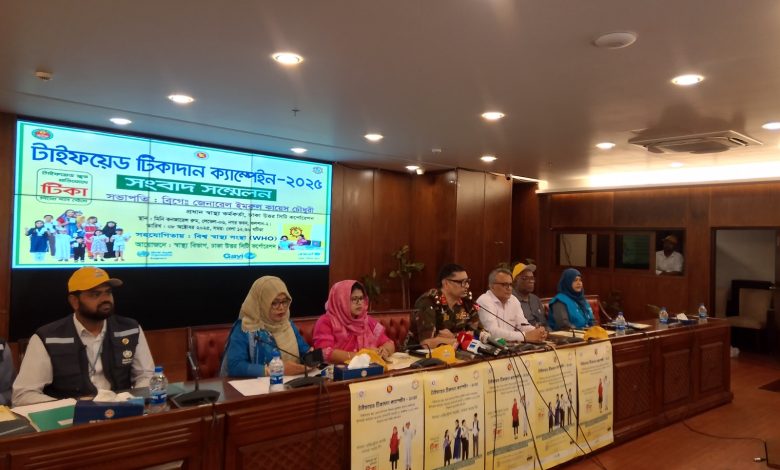Bangladesh Launches Typhoid Vaccination Drive to Save Millions

Bangladesh has launched a landmark nationwide typhoid vaccination campaign that aims to protect tens of millions of children and curb a growing public-health threat: drug-resistant typhoid fever. Beginning on October 12, 2025, the month-long drive will deliver a single dose of the Typhoid Conjugate Vaccine (TCV) to children aged nine months to under 15 years, reaching roughly 50 million children through schools, madrasas and community immunization sites. This is the country’s first-ever nationwide TCV catch-up campaign and one of the largest typhoid vaccination efforts in the region.
Why this campaign matters
Typhoid fever — caused by the bacterium Salmonella enterica serovar Typhi — remains a leading cause of febrile illness and childhood mortality in many low- and middle-income countries. In recent years the problem has become more complex because of the rise of antibiotic-resistant strains. When antibiotics that once reliably treated typhoid stop working, patient outcomes worsen, hospital stays lengthen, and health systems bear greater financial and logistical burdens.
The introduction of Typhoid Conjugate Vaccines is a game changer. TCVs are WHO-prequalified vaccines designed for use in infants and young children and require just a single dose for initial protection. They are more immunogenic than older typhoid vaccines and offer longer-lasting protection, making them ideal for routine immunization programs and mass catch-up campaigns in high-burden settings. International partners including Gavi, the World Health Organization (WHO), UNICEF and local health authorities have supported Bangladesh’s decision to run a nationwide campaign.
Scale and strategy of the campaign
The government’s plan is ambitious but carefully structured. Vaccinations are being delivered primarily through educational institutions during the first phase — reaching students in schools and madrasas — and through Union Parishad immunization centers and community outreach activities in subsequent days. The campaign is designed as a one-time catch-up for children up to 15 years of age and will also pave the way for TCV’s integration into routine childhood immunizations. Officials have emphasised that the vaccine will be given free of charge under the country’s Expanded Programme on Immunization (EPI).
To reach a target population measured in tens of millions, the campaign blends several delivery modalities: school-based vaccination for easy access to enrolled children; community-based sessions to reach out-of-school children; and routine EPI sites for those who are missed during the mass campaign. This hybrid approach is evidence-based and mirrors strategies used successfully in other large-scale vaccination drives in Bangladesh (such as polio and measles campaigns).
Expected impact: lives, antibiotics and health systems
Public-health modelling and real-world trials underline the potentially huge benefits of broad TCV coverage. Single-dose TCVs have demonstrated strong efficacy against typhoid, and accumulating evidence indicates protection lasting for at least four years — with some studies suggesting longer benefits. Protecting children across wide age groups can sharply reduce the incidence of typhoid, decrease hospitalizations and, crucially, reduce the demand for antibiotics that drives resistance. In a country where access to clean water and sanitation remains imperfect for many communities, vaccination is a powerful, immediate tool to cut disease and its downstream consequences.
Beyond direct health benefits, a successful campaign will relieve pressure on Bangladesh’s health system: fewer severe cases mean less strain on hospitals and clinics, lower health-care costs for families, and fewer lost school days for children. Policymakers and international partners frame TCV introduction not just as a medical intervention but as a strategic investment in the country’s human capital and economic resilience.
Logistics: cold chain, training and community engagement
Delivering a vaccine to 50 million children in one month poses formidable logistical and operational challenges. Bangladesh has mobilised its EPI infrastructure, health workers, teachers and community volunteers to execute the campaign. To protect vaccine potency, UNICEF and partners have bolstered cold-chain capacity: new cold rooms and equipment have been installed across districts to ensure TCVs are stored and transported at the correct temperatures. Health workers received training on vaccine administration, adverse event monitoring and record keeping to ensure safety and public confidence.
Community engagement is another critical pillar. In a campaign this large, vaccine acceptance depends on clear, consistent communication: why TCV is being introduced, who is eligible, where to get vaccinated, and what to expect. The government and partners used radio, television, social media, religious and community leaders to promote the campaign. School administrations are central, since school-based delivery simplifies access for millions of children and allows for efficient record keeping.
Equity considerations: reaching the hardest to reach
Bangladesh’s population includes many groups at greater risk of both infection and being missed by health services: urban slum dwellers, remote rural communities, migrants and children not enrolled in school. The campaign’s design recognises these realities by combining school-based approaches with outreach at Union Parishads, immunization centers, and community posts — and by scheduling evening and weekend sessions in some localities so working families can participate.
In addition, integrating TCV into routine immunization schedules after the catch-up campaign will help protect future birth cohorts and ensure long-term equity in vaccine access. Public-health experts argue that combining mass catch-ups with a commitment to routine provision is the most equitable, sustainable approach to disease control.
Safety and monitoring
Safety surveillance and the management of any adverse events following immunization (AEFI) are core components of the campaign. TCVs approved for national use are WHO-prequalified, meaning they meet international safety and quality standards. National EPI teams are working with WHO and partner organisations to track vaccinations in near-real time, monitor for any serious adverse reactions, and respond swiftly to queries from parents and communities. Transparent reporting and rapid response to safety concerns are essential to maintain trust and high vaccination uptake.
Cost and international support
A campaign of this magnitude requires substantial funding and logistical backing. Gavi has a history of supporting TCV introductions in eligible countries, including financing vaccine procurement and operational costs for catch-up campaigns in contexts where the epidemiology supports it. Bangladesh’s drive illustrates how national political will, international financing mechanisms, and technical partners can align to mount an effective public-health intervention at scale. Continued donor and domestic financing will be important if TCV is to be incorporated into the routine EPI schedule sustainably.
The antibiotic-resistance angle
One of the campaign’s most compelling arguments is its potential to slow the spread of antibiotic-resistant typhoid. In recent years, extensively drug-resistant (XDR) strains of S. Typhi have been reported in South Asia, and these strains drastically limit treatment options. Vaccination reduces the number of infections and therefore the number of occasions antibiotics are used — and misused — to treat fever. Over time, widespread TCV coverage should reduce selective pressure that favors resistant strains and help protect current antibiotic efficacy for other infections as well.
That said, vaccination is only one part of a multi-pronged response to antimicrobial resistance (AMR). Improved diagnostics, rational antibiotic stewardship, safe drinking water, sanitation, hygiene (WASH) improvements, and continued surveillance are all essential complements to vaccination.
What families and communities should know
Parents should know the eligibility criteria (children aged nine months to under 15 years), that the vaccine is offered free under the EPI during the campaign period, and that it requires a single dose. Minor, temporary side effects such as local soreness or low-grade fever can occur, but serious reactions are rare. Schools and community centers are primary delivery points during the initial weeks, so parents should check local announcements, school notices or EPI communications for exact dates and locations.
If a child missed vaccination at school, caregivers should visit the nearest Union Parishad immunization center or EPI site during the community phase of the campaign. Health officials have emphasised that the aim is to reach all eligible children, including those not in formal schooling.
Early reactions and the road ahead
Early reports from vaccination sites show long queues at schools and positive engagement from parents and teachers. The visible participation of school communities is a promising sign for uptake. Still, the campaign’s success will hinge on sustained coverage across districts and the ability to reach marginalized groups.
Looking forward, policymakers will evaluate campaign data to decide how best to incorporate TCV into routine schedules. If Bangladesh successfully achieves high coverage in this catch-up round, routine inclusion of TCV for infants could become the next logical step — a move that would provide a long-term reduction in typhoid burden for future generations.
Broader lessons for typhoid control
Bangladesh’s campaign offers several lessons relevant to other countries grappling with typhoid:
- Integration of partners matters. National health ministries, Gavi, WHO, UNICEF and local civil society each bring essential resources — financing, technical expertise, logistics and community reach — that together enable nationwide campaigns.
- School-based delivery is efficient. For large catch-ups that include school-aged children, leveraging schools captures a broad swath of the target population quickly and with lower marginal costs.
- Cold-chain investments pay dividends. Strengthening refrigeration and vaccine transport systems benefits other vaccination programs and emergency responses beyond the immediate campaign.
- Vaccination and WASH are complementary. While vaccination can sharply reduce disease, long-term control depends on improved water and sanitation infrastructure.
- Surveillance guides strategy. High-quality surveillance data on disease burden and antibiotic resistance should inform campaign design and help prioritise areas for intensified efforts.
Conclusion: a major step, not the finish line
Bangladesh’s nationwide typhoid vaccination drive is both historic and pragmatic: historic because of its unprecedented scale in the country, and pragmatic because it focuses on the twin problems of disease burden and rising antibiotic resistance. If implemented effectively, the campaign could avert thousands of cases, reduce the spread of resistant strains, protect schoolchildren, and free up health-system capacity for other needs.
But vaccinations are one chapter in a longer public-health story. Complementary investments in clean water and sanitation, antibiotic stewardship, continued surveillance, and routine immunization integration are necessary to consolidate gains. For now, Bangladesh has taken an important, evidence-based step toward saving lives and protecting children — and the world will be watching as the campaign unfolds and results emerge.




